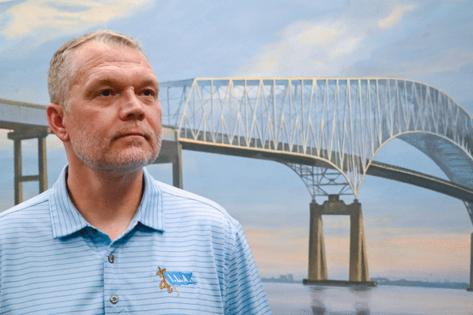Key Bridge collapse: Dockworkers, Port of Baltimore look to the future 1 year after disaster
Published in News & Features
BALTIMORE — Gwen Williamson arrived at 5:30 a.m. on March 26, 2024, at the union hiring hall in Dundalk, where the seasoned longshoreman expected to land a job running a top loader at the Port of Baltimore. Then came a surreal announcement as a dispatcher asked for prayers for all the victims of the bridge collapse.
“I said what bridge collapse?” Williamson recalled before staring at shocking footage of the fallen Francis Scott Key Bridge coming over her phone. “I couldn’t really fathom. I got a top loader that day, and when the sun came up, I looked out and saw the bridge wasn’t there.”
When the 100,000-ton Dali container ship collided with a bridge support, it plunged the span into the Patapsco River, killing six construction workers. The maritime disaster cut off a regional transportation artery and abruptly halted vessel traffic in and out of Baltimore’s port. The collapse put hundreds like Williamson out of work, including most of the 2,500 longshoremen who are part of a bigger daily workforce of 8,000 terminal, rail and tugboat operators, pilots and truckers.
Losses would ripple through the region for months as those who worked the docks and relied on port commerce struggled to adjust.
Cargo in and out of the port dried up. Full operations resumed June 12, but by the end of 2024, the port lost more than 6 million tons of cargo, a 12% year-over-year drop from a 52.3 million ton record in 2023. Volume fell in all key commodities — containers, cars, farm and construction equipment, forest products and “breakbulk,” non-containerized cargo, according to the Maryland Port Administration. The shutdown ended Baltimore’s 13-year consecutive streak of handling more cars than any other U.S. port.
“You can’t go through an extended shutdown like we did and not have significant impacts,” Jonathan Daniels, executive director of the Maryland Port Administration, said in an emailed response. “We are still recovering today. …We’re not all the way back yet.”
‘What are we going to do?’
Williamson, a longshoreman for 22 years, spent last March 26 driving equipment at a port terminal, moving boxes to be loaded on vessels. Then she went home and turned on the TV news.
“I burst into tears,” she said. “I guess it was a delayed reaction. I didn’t want to see it. I didn’t want to hear.”
For the Towson resident and grandmother, whose son also works at the port, and hundreds of others, work came to a standstill. At union meetings, some workers, particularly those with low seniority, appeared to be “in a spiral,” wondering, “what are we going to do?”
After the collapse, workers represented by three Baltimore locals of the International Longshoremen’s Association were without paychecks.
“It was like a light switch, off,” said Scott Cowan, president of ILA Local 333. “I wouldn’t wish that on any other port in the country because it was so devastating. But we came out better for it. We’re stronger, and the bridge is going to get rebuilt.”
Last week, the National Transportation Safety Board issued a finding that blamed the Maryland Transportation Authority for failing to conduct a necessary industry-standard risk computation. The NTSB said such an assessment would have found the chances of a vessel strike causing the Key Bridge to collapse were 30 times the acceptable level. State officials responded that the owner of the freighter was solely at fault.
Williamson said she assumed, given the age of the bridge, that hundreds of assessments would have been done.
“It would be extremely disheartening if the tragedy could have been avoided,” she said.
When the port shut down, some workers filled the hours driving for DoorDash or Uber or found work with Amazon. Williamson’s son, also a longshoreman, made deliveries for Walmart.
“Some of them were really despondent because they made a fairly decent wage,” she said. But she was amazed at how the community rallied, donating food, diapers and other assistance.
Second best port year ever despite shutdown
Vessel traffic returned slowly even after enough debris had been cleared to allow some ships back in. Because schedules tend to be planned months in advance, it took until around October for container traffic to rebound to about 85% the level of pre-bridge collapse. Auto traffic began to return but has flattened out both in Baltimore and elsewhere, hurt by conditions such as high interest rates and affordability worries.
Despite the shutdown, the port recorded its second-best year ever in 2024, handling 45.9 million tons of cargo, including more than 25.5 million tons during the last six months. It moved total cargo worth $62.2 billion, the third-highest annual cargo value in port history.
And despite falling from the top spot in the auto category, it finished first among U.S. ports for handling farm and construction equipment and also moved more imported forest products, used to make paper towels, napkins and tissues, than any other location.
Daniels said he expects autos to recover, thanks to the area’s skilled labor force, the proximity to the Midwest and the number of on-dock auto processors. The port finished second for cars last year and reported a 10% jump in the category in January.
In the wake of the collapse, few unionized dock workers chose to leave the area or get into other lines of work, Cowan, the union president, said. The ILA and U.S. Maritime Alliance, a group of port operators and shipping lines, offered help through a disaster fund to supplement unemployment for members. Grants of $1,000 were available to union workers, contractors, solo owner-operators and self-employed workers at terminals through the Baltimore Community Foundation.
“These programs kept everybody going,” Cowan said. “It’s hard to give this job up. It’s a union job. It pays good. They’ve got good benefits.”
About a fifth of the Baltimore-area union workers who are classified as full-time mostly kept working at terminals for operator Ports America, catching up on crane repairs and other maintenance. But few left the ranks, even among those who line up at the hiring hall daily or when ships come in.
The union has about 3,000 applications for general dockworkers on file now and hasn’t taken in any new members since the bridge fell.
“It’s been a little tighter because roll-on roll-off cargo has been a little bit flat,” Cowan said. “But it is picking up every month.”
First woman to operate such machinery
On a cold, sunny morning in early March, workers in yellow and orange vests gathered at Dundalk Marine Terminal near the Heerengracht Amsterdam, a “break bulk” cargo ship that had sailed into the port the night before. A lone piece of equipment sat on the dock at the general cargo terminal, awaiting its next move.
Across the channel at Seagirt Marine Terminal, the port’s main container facility, an operator of a massive “Neo-Panamax” crane directed the lifting of a large container from the stack on Hong Kong-flagged Zim Topaz. The operator guided the box over the container ship and toward shore.
Farther into the terminal, smaller but massive rubber-tired gantry cranes navigated their way through cargo bound for tractor-trailers. That’s the kind of work where Williamson, the first woman at Seagirt to operate such machinery, has made her mark. She’d often start a 6 a.m. shift by climbing the 85-foot crane’s dozens of steps.
After working 20 years as a new homes analyst for Baltimore Gas and Electric Co., she applied at the port during open hiring after a longshoreman friend dropped off an application for her son. He wasn’t interested at the time, but the job appealed to Williamson, who also used to drive a mass transit bus and always gravitated toward “non-traditional” work.
Her early jobs at the port included driving cars off vehicle cargo ships, one day a Rolls Royce, another a Lamborghini. She progressed to military vehicles and crop dusters. She jumped at any chance to add to her training, becoming certified in operating top loaders, then the larger RTGs. She has put operating those larger cranes on hold because of recent back surgery.
Long-term financial impacts of the port closure are still being assessed, Daniels said.
The state and other government officials are seeking millions in damages, including losses resulting from the closure, from Synergy Marine Corp., operator of the Dali, and Grace Ocean, its owner.
Tariffs bring uncertainty
In the meantime, the MPA is moving forward with growth plans to make Baltimore one of the most cargo-diverse ports in the country. Last fall, the port began handling double-stacked containers by rail with CSX and Ports America Chesapeake, a private terminal operator and stevedore and the port’s largest employer.
The port started handling double-stacked containers by rail using a temporary route into the Midwest with CSX and Ports America. The completion of the long-planned Howard Street tunnel reconstruction next year will allow CSX to run tall, double-stack, intermodal trains on its own tracks through the Mid-Atlantic states for the first time, boosting business by an estimated 160,000 containers annually and creating more than 3,000 jobs.
Container business is also expected to jump with Tradepoint Atlantic’s plans to develop a new container terminal in Sparrows Point.
And Ports America’s additional investment in Seagirt infrastructure has led to the terminal setting three records so far this year, port officials said, beating a record for one-day gate transactions and two for the number of container moves and the number of twenty-foot containers off one vessel.
The recent Trump administration tariffs have brought new uncertainty to the port. Any impact would be felt not only in Baltimore but at ports across the U.S., Cowan said
“I don’t know what the tariffs are going to bring,” Cowan said. “What I do know is nobody’s going to have a better advantage over the cargo than us.”
That’s because the relationship between the ILA and the port with Ports America is better than it’s ever been, he said. And with plans for the new Sparrows Point terminal, investment at Seagirt, and expanded Midwest rail access, Cowan sees a bright future for container business, the “prize of the shipping industry.”
The bigger challenges, he said, will be “competing with the states in the south and investing in the infrastructure of the port” as Maryland struggles with a growing budget deficit and as competing states “pour money into their ports.” He argues that investing in maintenance and attracting cargo pays off in jobs, tax revenue and a stronger state economy.
“We have the port,” he said. “We know what it can do. Let’s invest. Let’s get the cargo here.”
_____
©2025 The Baltimore Sun. Visit at baltimoresun.com. Distributed by Tribune Content Agency, LLC.







Comments